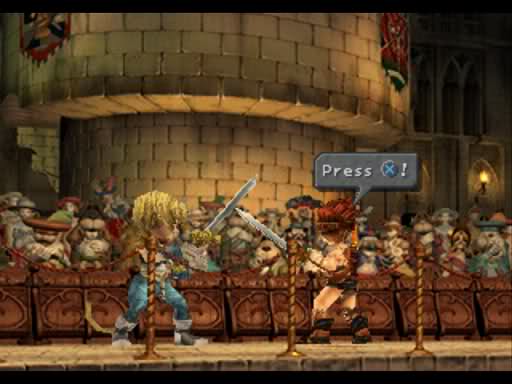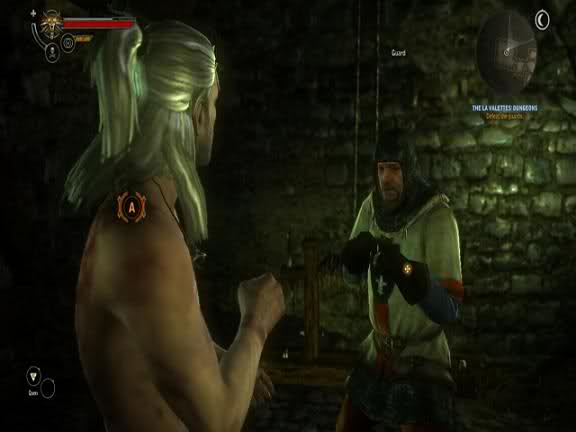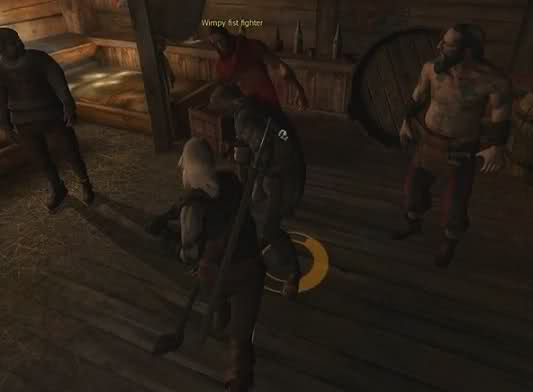
Geralt of Rivia, battle-hardened swordsman, is victorious. All his enemies lie in pools of fresh blood, a testament to the hard, long battle behind him. More than once, his death seemed a certainty. But in the end – victory.
Suddenly, a ferocious dragon sweeps down from the skies. Geralt races across the castle walls, but before he can react, the winged serpent unleashes a torrent of smoldering flame, burning Geralt alive.
And as I sit there, staring at my computer screen with the words ‘Game Over’, one thought runs over and over through my brain:
“I hate QTEs.”
Oh, CD Projekt Red. Why do you test me so?
Look, I like you guys, I really do. The Witcher, despite its many, many faults, was one of my highlights last year. Your digital service, GOG, has given me some great gaming classics I missed. Your company’s stance towards DRM is nothing short of wonderful. And as I play through your second title, The Witcher 2, I can see that the game is shaping up to be pretty damn solid.
So what the hell happened with these Quick Time Events?
I know, quick time events are not inherently bad. They can be darn effective in the right circumstances. Hell, just take a look at this:

En Garde!
This swordfighting section from Final Fantasy IX is probably the best QTE I’ve ever encountered. It’s simple, it makes sense, and most important, it’s fun.
Yours…aren’t. As I play The Witcher 2, many cinematics use QTEs as tacked-on barriers where failure is instant death. The end result is frustration and a sense of pointlessness. And while the game gives the option to turn them off, that doesn’t really excuse the option to leave them on.
Seriously, it’s been more than a decade since we started using QTEs. I’d have thought we’d have these things down by now.
Okay, I realize I’m getting snippy, but it really bugs me to see such a good company mess up on such a simple thing. Let me break it down for you:
1. Make it clear what action each button press will perform.
Doing this will do wonders. Trust me. The simple act of adding context will transform the complaint “I missed the X button” into the statement “I didn’t jump in time”. Failure will be interpreted as a personal misstep and not a design fault, and likewise, success will be a personal triumph rather than an empty victory.
The key is that context needs to be established before the point of success or failure.
2. Use established button mapping.
There is no point in using new buttons for already-established actions. If your game already has commands for Jump, Attack, Strafe Left and Strafe Right, then use those same commands whenever your character performs those actions in a QTE. For example, if I’m dodging dragonfire, why should I press the button that normally triggers a heavy attack?

Now, yes, the fistfighting minigame in The Witcher 2 uses the WASD movement buttons to dodge blows, but there are two problems: first, a single directional button won’t always (in fact, will rarely) trigger Geralt to move in the same direction. Second, the WASD commands also trigger punches and throws. The result is that I feel completely disconnected from what Geralt does.
3. Make buttons for new actions make sense.
Not every action in your QTE will have an established button in the game engine, I realize, so when a new action is used, it should be triggered in a natural way. For example, the action of shaking off an enemy should be a back-and-forth on directional movement keys; drawing back a bowstring should be to press and hold a button; barreling through a crowd should be a quick succession of a single button.
You’re pretty good at this already, but I thought I’d mention it just in case.
4. Failure != Instant Death.
Ohmygod no.
This is especially important when using previously unmapped actions in a QTE. Killing the player for not performing a single unexpected, unpredictable button press is tantamount to giving him the finger. Instant death should be only be used in extreme cases.
Instead, death (or Game Over) can be determined by the number of failures in a succession of button presses, judging player performance as a whole and not as a singular instance. Another alternative is to give the player opportunities to retry the QTE section after a duration of extra gameplay, such as when failing to deliver the final blow to a difficult boss (In fact, you did exactly that later on in the game).
Heavy Rain, by different token,takes an approach where failure changes how the story unfolds, possibly causing undesirable, yet canonical, consequences.
And finally…
5. If the QTE can be replaced by gameplay, DO IT!
While QTEs can be effective, they usually create a barrier between what the player does and what the character does, regardless of the above suggestions. Removing QTEs and integrating them into gameplay, whenever possible, tears down this barrier and makes the player feel like he has control over what happens.

It boggles my mind that you replaced a fully-functional brawling section from your last game, one that used combat controls as input, with a needless, awkward QTE. Geralt can attack; he can dodge; he can even block. Get rid of that QTE, and every punch will have weight and a sense of personal satisfaction.
The flip side to this rule is that, if your cinematic has an unintuitive, instant-death, QTE, nix it! I’ll accept a pure cinematic.
I won’t accept a broken game mechanic.